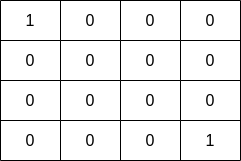Description
You are given a 0-indexed 2D matrix grid of size m x n, where (r, c) represents:
- A land cell if
grid[r][c] = 0, or - A water cell containing
grid[r][c]fish, ifgrid[r][c] > 0.
A fisher can start at any water cell (r, c) and can do the following operations any number of times:
- Catch all the fish at cell
(r, c), or - Move to any adjacent water cell.
Return the maximum number of fish the fisher can catch if he chooses his starting cell optimally, or 0 if no water cell exists.
An adjacent cell of the cell (r, c), is one of the cells (r, c + 1), (r, c - 1), (r + 1, c) or (r - 1, c) if it exists.
Example 1:

Input: grid = [[0,2,1,0],[4,0,0,3],[1,0,0,4],[0,3,2,0]] Output: 7 Explanation: The fisher can start at cell(1,3)and collect 3 fish, then move to cell(2,3)and collect 4 fish.
Example 2:

Input: grid = [[1,0,0,0],[0,0,0,0],[0,0,0,0],[0,0,0,1]] Output: 1 Explanation: The fisher can start at cells (0,0) or (3,3) and collect a single fish.
Constraints:
m == grid.lengthn == grid[i].length1 <= m, n <= 100 <= grid[i][j] <= 10
Solution
Python3
class Solution:
def findMaxFish(self, grid: List[List[int]]) -> int:
rows, cols = len(grid), len(grid[0])
res = 0
def go(x, y):
total = grid[x][y]
grid[x][y] = 0
for dx, dy in [(x + 1, y), (x - 1, y), (x, y + 1), (x, y - 1)]:
if 0 <= dx < rows and 0 <= dy < cols and grid[dx][dy] != 0:
total += go(dx, dy)
return total
for x in range(rows):
for y in range(cols):
if grid[x][y] != 0:
res = max(res, go(x, y))
return res